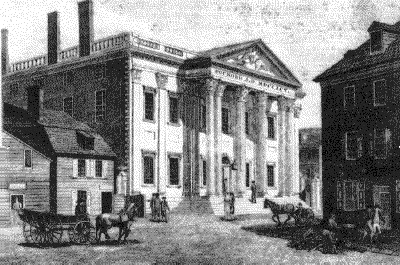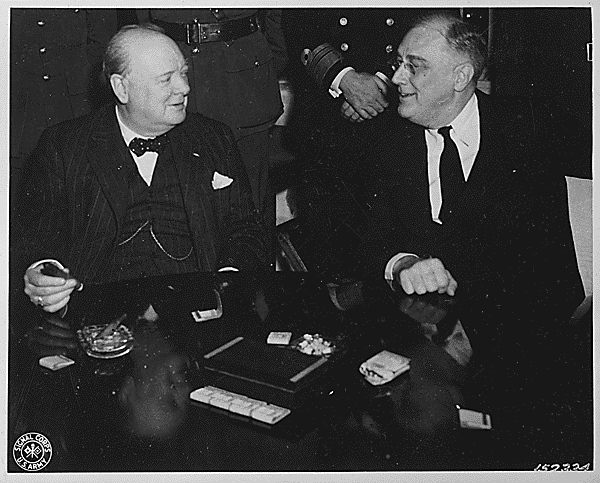|

The First National Bank of the U.S.
The term American System was first used by Alexander Hamilton in the Federalist papers.
The European Renaissance
The roots of America are found in the European Renaissance of the 15th and 16th century. Prior to this historic event, all
societies were governed by an aristocracies that reduced the vast majority of men to a status little better than cattle. The
Renaissance brought forth the idea that society must be governed by the idea that each man is made 'in the image of god.'
Another crucial event was the founding of nation state, by Louis XI (1461-1483) in France and Henry VII (1485-1509)
in England. For the first time societies were organized around the committment to general welfare for all citizens.
For a review of the natural law conceptions that inspired the American Revolution:
Leibnizian Natural Law
The Constitution of the U.S. and the American System
'We the People of the United States, in Order to form a more perfect Union, establish Justice, insure domestic Tranquility,
provide for the common defence, promote the general Welfare, and secure the Blessings of Liberty to ourselves and our Posterity,
do ordain and establish this Constitution for the United States of America.'
Preamble of the U.S. Constitution
After the Battle of Yorktown, in 1782, it became clear that Great Britain had lost the American Revolution.
The elites in Britain attempted to take back, through cunning, what they had lost in war. The British included a clause in
the peace treaties that they signed with the new American Republic, and America's French allies, requiring that both America
and France adhere to 'free trade' with Britain.
The British promptly launched an economic war, dumping cheap
goods on American markets, and nearly destroying the industries that had been built up during the Revolutionary war. America
was in danger of becoming economically dependent on the British Empire that had just been defeated in war.
American
patriots responded to this new threat by establishing a new Constitution that gave the central government the power to defend
the nation against this economic warfare. The Constitution of the United States of America was the first Constitution that
explicitly stated purpose of the nation to promote the general welfare, and gave the central government the power to promote
the nation's development.
Key elements in the new Constitution were:
*The Preamble which established the
nations committment to the general welfare of the people and their posterity.
*The Article 1 Section 8 which gave the
Congress the power to control the money, and direct monetary policy to meet the needs of the nation for development.
*The
creation of a strong executive branch with the power and foster internal improvements.
The basic outline for
economic development, which was contained in the Consitution were fleshed out by Alexander Hamilton, who became the nation's
first Secretary of the Treasury, under President George Washington. Several of his key initiatives were:
*Hamilton's
Report to the Nation on Manufactures
*The establishment of a National Bank to finance infrastructure projects for internal
improvement.
The key concepts embodied in the U.S. Constitution and the 'American System' were developed by Alexander
Hamilton, James Madison, and John Jay in 'The Federalist Papers':
The American System developed in "The Federalist Papers"
The Lincoln Revolution
The reforms of the Lincoln administration created one of the most rapid periods of economic development in the history of
any nation. Lincoln combined a highly protectionist policy with programs for internal improvements, such as the transcontinental
railroad and the land grant colleges.
The fight to end slavery was a war against British subversion. Slavery was
consciously promoted in the American colonies by aristocratic groupings in Britain to block republican thinking in the colonies.
The British actively aided the Southern succession.
Into the 20th Century
| Franklin Roosevelt and Churchill at Casablanca |

|
| Franklin Roosevelt sought to end British colonialism |
The tradition of the American System was continued by President William McKinley.
However, McKinley was assassinated and replaced by an admirer of the British and the Confederacy, Teddy
Roosevelt and his "big stick" diplomacy.
Franklin Roosevelt shifted the nation back to the American System with
his "New Deal." However, Roosevelt died before he was able to eradicate colonialism, as he had intended.
The history
of the American System has been largely removed from the history books. Almost all of today's historians claim that America
was built by the very "free trade" policies that America was founded to oppose.
Franklin Roosevelt's Battle Against Colonialism
The New Bretton Woods System:
Framework for a New, Just World Economic Order
The tradition of the American System is continued today by Lyndon LaRouche. LaRouche has designed a series of great projects
for world development. To visit a site with these projects:
LaRouche's Great Projects for economic development
Lyndon LaRouche delivered this keynote address to a conference held on Jan. 14-17, 2001 in Khartoum, Sudan, which was co-sponsored
by the Sudanese Ministry of Information and Culture, the Centre for Strategic Studies of Sudan, EIR, and the Schiller Institute,
on the subject of "Peace Through Development Along the Nile Valley in the Framework of a New, Just World Economic Order."
The New Bretton Woods
Please return soon!
Much will be added to this section.
|

